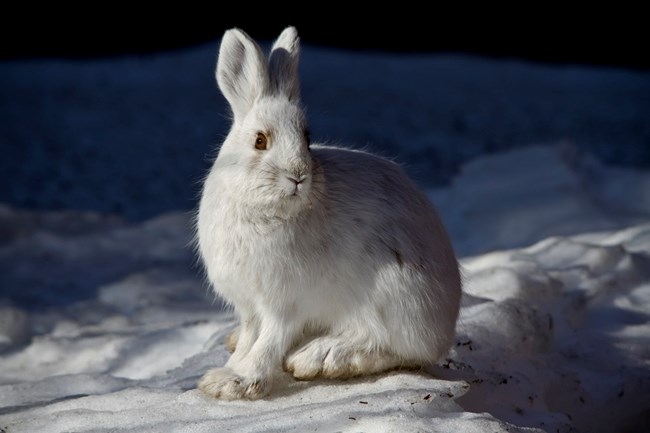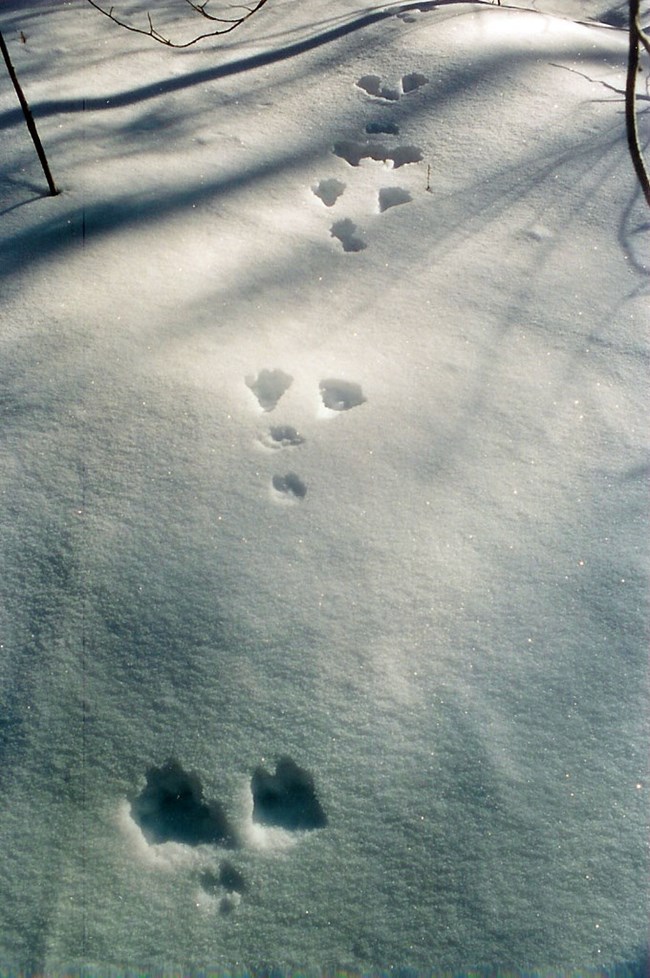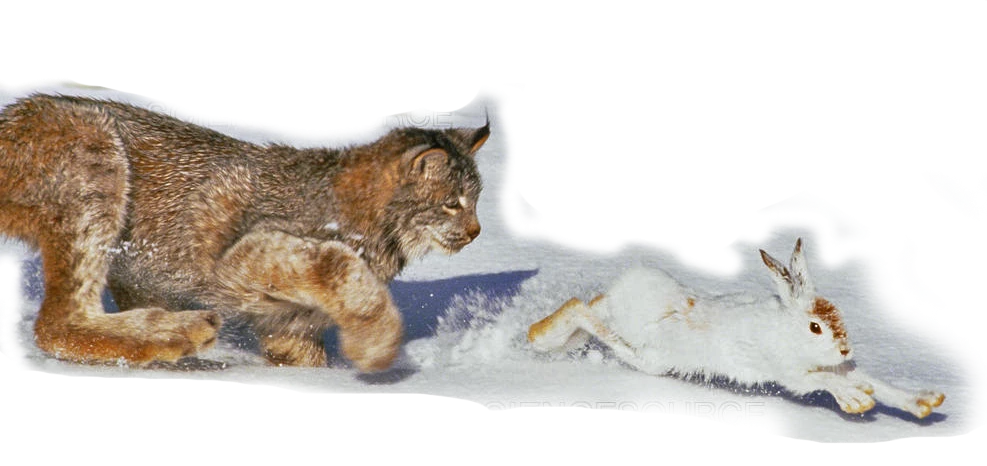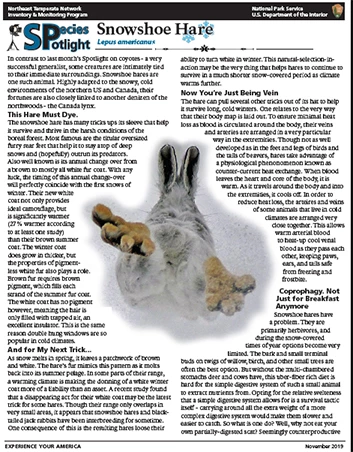Last updated: August 15, 2021
Article
NETN Species Spotlight - Snowshoe Hare


In contrast to last month’s Spotlight on coyotes - a very successful generalist, some creatures are intimately tied to their immediate surroundings. Snowshoe hares are one such animal. Highly adapted to the snowy, cold environments of the northern US and Canada, their fortunes are also closely linked to another denizen of the northwoods - the Canada lynx.
This Hare Must Dye.
The snowshoe hare has many tricks ups its sleeve that help it survive and thrive in the harsh conditions of the boreal forest. Most famous are the titular oversized furry rear feet that help it to stay atop of deep snows and (hopefully) outrun its predators. Also well known is its annual change over from a brown to mostly all white fur coat. With any luck, the timing of this annual change-over will perfectly coincide with the first snows of winter. Their new white coat not only provides ideal camouflage, but is significantly warmer (27% warmer according to at least one study) than their brown summer coat. The winter coat does grow in thicker, but the properties of pigment-less white fur also plays a role. Brown fur requires brown pigment, which fills each strand of the summer fur coat. The white coat has no pigment however, meaning the hair is only filled with trapped air, an excellent insulator. This is the same reason double hung windows are so popular in cold climates.
And for My Next Trick...
As snow melts in spring, it leaves a patchwork of brown and white. The hare’s fur mimics this pattern as it molts back into its summer pelage. In some parts of their range, a warming climate is making the donning of a white winter coat more of a liability than an asset. A recent study found that a disappearing act for their white coat may be the latest trick for some hares. Though their range only overlaps in very small areas, it appears that snowshoe hares and black-tailed jack rabbits have been interbreeding for sometime. One consequence of this is the resulting hares loose their ability to turn white in winter. This natural-selection-in-action may be the very thing that helps hares to continue to survive in a much shorter snow-covered period as climate warms further.

Now You’re Just Being Vein
The hare can pull several other tricks out of its hat to help it survive long, cold winters. One relates to the very way that their body map is laid out. To ensure minimal heat loss as blood is circulated around the body, their veins and arteries are arranged in a very particular way in the extremities. Though not as well developed as in the feet and legs of birds and the tails of beavers, hares take advantage of a physiological phenonomenon known as counter-current heat exchange. When blood leaves the heart and core of the body, it is warm. As it travels around the body and into the extremities, it cools off. In order to reduce heat loss, the arteires and veins of some animals that live in cold climates are arranged very close together. This allows warm arterial blood to heat-up cool venal blood as they pass each other, keeping paws, ears, and tails safe from freezing and frostbite.
Coprophagy. Not Just for Breakfast Anymore
Snowshoe hares have a problem. They are primarily herbivores, and during the snow-covered times of year options become very limited. The bark and small terminal buds on twigs of willow, birch, and other small trees are often the best option. But without the multi-chambered stomachs deer and cows have, this uber-fiber rich diet is hard for the simple digestive system of such a small animal to extract nutrients from. Opting for the relative svelteness that a simple digestive system allows for is a survival tactic itself - carrying around all the extra weight of a more complex digestive system would make them slower and easier to catch. So what is one do? Well, why not eat your own partially-digested scat? Seemingly counterproductive to health and well-being, this practice is actually crucial to their survival. Many plant parts pass practically pristine through the hare’s stomach and small intestine, and thus still clutching to much of their nutritional value. Once they reach the cecum (a pouch-like area atop the large intestine), bacteria can begin its work fermenting and breaking the woody material down into essential proteins and B-vitamins, but this is too far down the line for the hare to absorb the nutrition. After a day of eating, the hare defecates nutrient rich, soft, dark, and tarry “cecotropes” at night. They are immediately consumed, unlocking access to these key nutrients on the second pass-through. When ejected next, they look like the more familiar tiny round balls of woody material.

The Circle of Life. And Death.
Snowshoe hare are considered a “keystone species.” This essentially means they have a disproportionate effect on many other species that inhabit their sphere. They are important prey for coyote, fox, and at least 10 species of hawks and owls, and when their numbers are high, they can greatly impact vegetation. But in what may be the most famous predator-prey relationship in the natural world, the populations of Canada lynx are intimately tied to that of snowshoe hare.
That snowshoe hare populations rise and then crash about every 10 years has been a known phenomenon for centuries. But the mechanisms behind this clockwork-like cycle have never really been 100% understood. In the same way that trying to explain how a bike wheel got from Point A to Point B by only studying a single spoke, it is impossible to understand the hare cycle by only looking at the hare. Hare numbers are linked to many other “spokes” in the northwoods ecosystem that help drive the cycle. Ecologists are reasonably confident some combination of hare population numbers, predator numbers, and food availability/physiology have a hand to play in this boom-bust cycle.
The main theory goes something like this: at the beginning of a 10-year cycle, hare numbers are low having just crashed and lynx numbers are high after feasting on years of high hare abundance. Sometimes the favorite winter food of hare, willows, have been severely browsed and repressed by this time. After a year or two of low hare numbers, lynx numbers crash and willows start to recover. As predator pressures are relaxed and food availability begins to rise again, so too do populations of hare. They do what they do best, and after several more years their numbers are rapidly rising again. Of course this flush of prey means that lynx numbers also begin to rise once again. More surprisingly, as willows are ever more merrily munched by the hares, they begin to change their chemical make-up. Willows start to produce large amounts of toxins that makes them unpalatable to the hare, which then focus more on bog birch and other trees, stunting their growth. Amazingly, the willows only concentrate the toxins in the lower couple feet of their make-up, meaning that another willow consumer, the moose, can still enjoy one of its favorite winter meals unsullied. Psychological stress from constant predator pressure and lowering food availability appears to cut mother doe hares’ reproductive output in half. As they get squeezed from all sides, hare numbers suddenly crash, starting the cycle anew. This happens pretty much without fail every 9 to 11 years over large swathes of Canada.
For more
- Watch this video of a classic ritual of the northwoods: a Canada lynx - snowshoe hare chase in deep snow.
Tags
- acadia national park
- appalachian national scenic trail
- eleanor roosevelt national historic site
- home of franklin d roosevelt national historic site
- marsh - billings - rockefeller national historical park
- minute man national historical park
- morristown national historical park
- saint-gaudens national historical park
- salem maritime national historical park
- saratoga national historical park
- saugus iron works national historic site
- vanderbilt mansion national historic site
- weir farm national historical park
- species spotlight
- netn
- inventory and monitoring division
- mammals
- snowshoe hare
- lynx
- alaska
- mammals.
